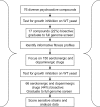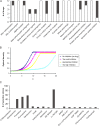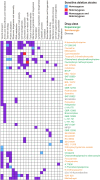Off-target effects of psychoactive drugs revealed by genome-wide assays in yeast
- PMID: 18688276
- PMCID: PMC2483942
- DOI: 10.1371/journal.pgen.1000151
Off-target effects of psychoactive drugs revealed by genome-wide assays in yeast
Abstract
To better understand off-target effects of widely prescribed psychoactive drugs, we performed a comprehensive series of chemogenomic screens using the budding yeast Saccharomyces cerevisiae as a model system. Because the known human targets of these drugs do not exist in yeast, we could employ the yeast gene deletion collections and parallel fitness profiling to explore potential off-target effects in a genome-wide manner. Among 214 tested, documented psychoactive drugs, we identified 81 compounds that inhibited wild-type yeast growth and were thus selected for genome-wide fitness profiling. Many of these drugs had a propensity to affect multiple cellular functions. The sensitivity profiles of half of the analyzed drugs were enriched for core cellular processes such as secretion, protein folding, RNA processing, and chromatin structure. Interestingly, fluoxetine (Prozac) interfered with establishment of cell polarity, cyproheptadine (Periactin) targeted essential genes with chromatin-remodeling roles, while paroxetine (Paxil) interfered with essential RNA metabolism genes, suggesting potential secondary drug targets. We also found that the more recently developed atypical antipsychotic clozapine (Clozaril) had no fewer off-target effects in yeast than the typical antipsychotics haloperidol (Haldol) and pimozide (Orap). Our results suggest that model organism pharmacogenetic studies provide a rational foundation for understanding the off-target effects of clinically important psychoactive agents and suggest a rational means both for devising compound derivatives with fewer side effects and for tailoring drug treatment to individual patient genotypes.
Conflict of interest statement
The authors have declared that no competing interests exist.
Figures





References
-
- WHO. World Health report. Geneva 2001.
-
- Arana GW. An overview of side effects caused by typical antipsychotics. J Clin Psychiatry. 2000;61(Suppl 8):5–11. discussion 12–13. - PubMed
-
- Alvir JM, Lieberman JA, Safferman AZ, Schwimmer JL, Schaaf JA. Clozapine-induced agranulocytosis. Incidence and risk factors in the United States. N Engl J Med. 1993;329:162–167. - PubMed
-
- Merrill DB, Ahmari SE, Bradford JM, Lieberman JA. Myocarditis during clozapine treatment. Am J Psychiatry. 2006;163:204–208. - PubMed
-
- Varambally S, Howpage P. Acute myocarditis associated with clozapine. Australas Psychiatry. 2007;15:343–346. - PubMed
Publication types
MeSH terms
Substances
LinkOut - more resources
Full Text Sources
Other Literature Sources
Molecular Biology Databases

